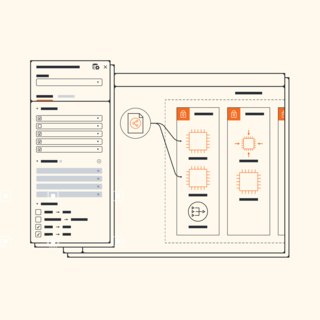
Cloud incident response best practices
Lucid Content
Reading time: about 7 min
Today, downtime costs for data center-dependent businesses are rising faster than average. And when downtime costs nearly $9,000 per minute on average, businesses must find ways to mitigate risks and manage incidents quickly and effectively.
Incident response management is the unsung hero of software development and IT operations. A good incident response process works behind the scenes to ensure issues are resolved quickly so that communication, performance, and development can continue to operate unhindered.
Below we’ll cover why cloud incident management is important and the incident management best practices you can apply to keep your systems running smoothly.
Overview of cloud incident response
An incident is an unplanned interruption or reduction of quality in an IT service. In a world where reliability is crucial in preventing costly downtime and mitigating security and business risks, companies must invest in a robust incident response management process.
Traditional IT service management (ITSM) relies on multiple applications and platforms to monitor, track, and alert teams to incidents as they evolve.
Because incidents affect performance, downtime, and even security, it is crucial for IT teams to respond to (and even anticipate) problems quickly and accurately. However, traditional ITSM simply can’t keep up with the velocity of today’s modern development teams.
Enter: the cloud.
DevOps relies on transparency, collaboration, and speed for seamless rapid deployment. Cloud incident response makes that possible. Cloud incident response brings all these functions into one place for a streamlined and efficient incident response system that includes monitoring, communication, documentation, and alerting.
As a result, cloud incident response teams are better equipped to collaborate, track processes, and automate key security tasks.
Best practices
Despite the clear advantages, incident response in the cloud does bring its own challenges and unique requirements. Use the following cloud incident response best practices to make sure your incidents don’t become crises.
1. Put a process in place before an incident happens
You won’t be able to predict every type of incident or situation that you will need to address. However, it’s important to be prepared.
Develop playbooks of standard procedures for responding to incidents. An incident response management process helps you:
- Resolve incidents faster
- Improve internal and external communication
- Reduce revenue losses
- Promote continuous learning and improvement
Outline scripts that your team can follow to communicate with customers and stakeholders about critical outages. Make sure your processes are updated regularly (automate where possible) and that team members have access to the training guides.
Having a recovery plan in place ensures you are ready to address incidents quickly and confidently, reducing the risk of costly miscommunication and confusion.
2. Assess impact and prioritize risks
When you detect an incident, you need to be able to make quick decisions. What is the problem? What risks does it pose? Which risks are most important to address? Who does it impact?
You’ll need to answer these questions under pressure and as quickly as possible to mitigate risks and reduce business disruption.
To determine your response, assess impact and prioritize risks using key monitoring systems and escalation and diagnosis processes. Make sure you have clear channels of communication between team members, as well as outlined expectations for responsibility.
Define your priority and severity levels before an incident occurs so incident managers can quickly assess and determine priorities in the heat of the moment. Address all future incidents in order of priority.
Pro Tip: When in doubt, err on the side of caution and escalate the incident to a higher priority.
3. Invest in the right tools
Cloud architecture is often large and complex, with many moving parts to track and monitor. That’s why it’s important to invest in the right incident management tools to support your cloud incident response processes.
- Lucidscale—Visualize your cloud architecture and monitor incidents and response with up-to-date, at-a-glance visibility of your network.
- Splunk—Harness data insights through real-time monitoring and visibility of your environments to address incidents before they impact customers.
- Confluence—Collaborate from one shared workspace to improve communication, clarify responsibilities, and improve accountability using features like meeting notes, templates, and document sharing to operate from one source of truth.
- IBM QRadar—Access comprehensive insights and analytics into your cloud environment to quickly identify, assess, and respond to potential threats and accelerate investigation processes.
- Demisto—Streamline security orchestration with automated security processes, improve collaboration across silos, and connect disparate tools and technologies.
Automate where you can. This includes any mundane, repetitive tasks that take up valuable time and attention. Use automation to relieve incident managers of additional noise and help everyone focus on the most important tasks at hand.
4. Use diagrams
Cloud environments are complex and security incidents often go undetected because teams work in silos or the volume of incidents is overwhelming, making it difficult to identify priority issues.
Visualize your processes and map your cloud architecture to keep everyone on the same page and prevent incidents from falling through the cracks.
Use diagrams to outline your incident response processes, including steps each team or role is responsible for and the chain of communication. Create a map of your cloud architecture so it's easy to understand your cloud environment and how components work together. This also makes it easy to share insights and recommendations with stakeholders, confirm what the environment looks like, and reduce silos by bridging the communication gap between remote teams.
Lucidscale makes it easy to visualize your cloud environment. In just a few clicks, connect your Lucidchart account to your cloud environment through third-party access and automatically generate a diagram of your cloud infrastructure organized by cloud, region, instance and other resources.
5. Overcommunicate
When it comes to incident response, there’s no such thing as too much communication. Take advantage of your incident response playbooks, messaging scripts, and process flows to ensure everyone is on the same page.
Keep documentation clear. Log and categorize every incident. Every ticket should typically include:
- Name of the person reporting the incident
- Date and time of the report
- Incident description (what isn’t working)
- A unique ID for tracking that incident
If you need to communicate to a large internal group, consider creating a status page for tracking incident updates.
There are so many moving parts to incident management. The better you can map out roles, responsibilities, communication channels, and expected processes, the easier communication will be and the less likely anything will fall through the cracks.
6. Host a postmortem
Cloud incident response relies on a culture of continuous improvement. Conduct a postmortem after each incident.
Track and analyze incidents in a central database so you can understand what went wrong after each incident, what steps were taken to fix it, and what the results were. Measuring and analyzing incident data over time can help you respond to future incidents more effectively, and identify patterns or weaknesses in your infrastructure that need to be addressed.
How Lucidscale helps
Lucidscale takes the guesswork out of cloud incident response management by helping DevOps and security teams:
- Visualize their processes
- Manage incidents from a centralized, accessible cloud-based application
- Visualize cloud architecture automatically
- Collaborate and communicate across silos and within teams
- Integrate Lucidchart solutions seamlessly with other applications you already use
Additionally, Lucidchart collaboration features help incident teams visualize and follow an effective process that may reduce the time it takes to restore uptime in the cloud.
For example, Lucidchart is cloud-based so everyone can access documents centrally and from any device or operating system at any time. You can @mention users and comment on shapes to direct individuals to exactly where action is needed.
You can even link to external documents, such as Jira tickets or Confluence pages. Lucidchart makes it easy to manage your cloud network using your favorite cloud management tools through seamless third-party integrations.
Including your architecture diagrams in Confluence wikis or Jira tickets can also help incident teams communicate during the process. This means that they can identify and resolve issues faster because the visual provides additional context. You can host a post mortem after the incident, too, using your architecture diagram to review where an issue occurred.
Lucidscale was designed with DevOps and cloud management teams in mind. Lucidscale automatically visualizes your cloud architecture, so you don’t have dig through lines of code or spreadsheets, trying to identify where an issue may be.

Level up your incident response management and make smarter cloud decisions today with Lucidscale.
Learn howAbout Lucidchart
Lucidchart, a cloud-based intelligent diagramming application, is a core component of Lucid Software's Visual Collaboration Suite. This intuitive, cloud-based solution empowers teams to collaborate in real-time to build flowcharts, mockups, UML diagrams, customer journey maps, and more. Lucidchart propels teams forward to build the future faster. Lucid is proud to serve top businesses around the world, including customers such as Google, GE, and NBC Universal, and 99% of the Fortune 500. Lucid partners with industry leaders, including Google, Atlassian, and Microsoft. Since its founding, Lucid has received numerous awards for its products, business, and workplace culture. For more information, visit lucidchart.com.
